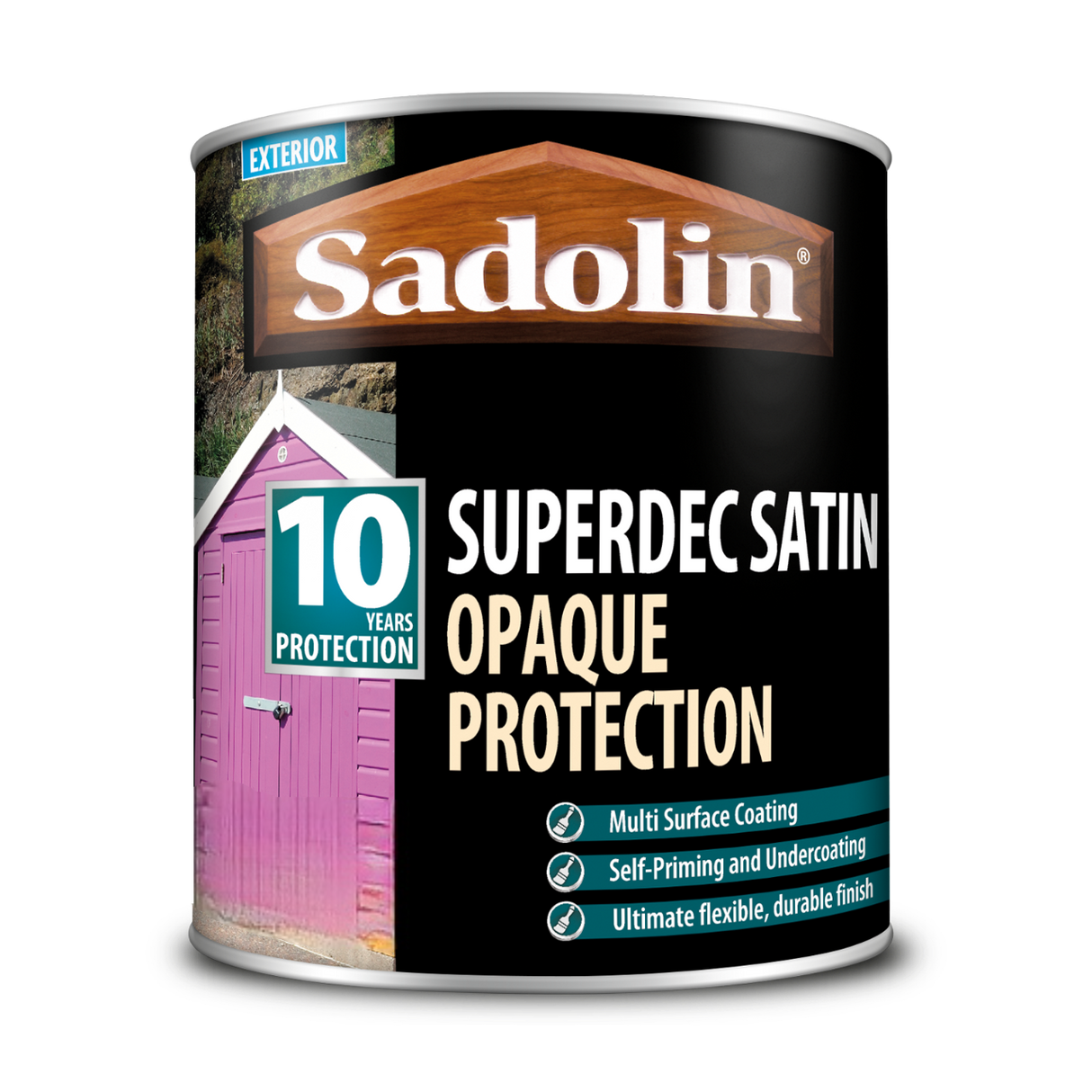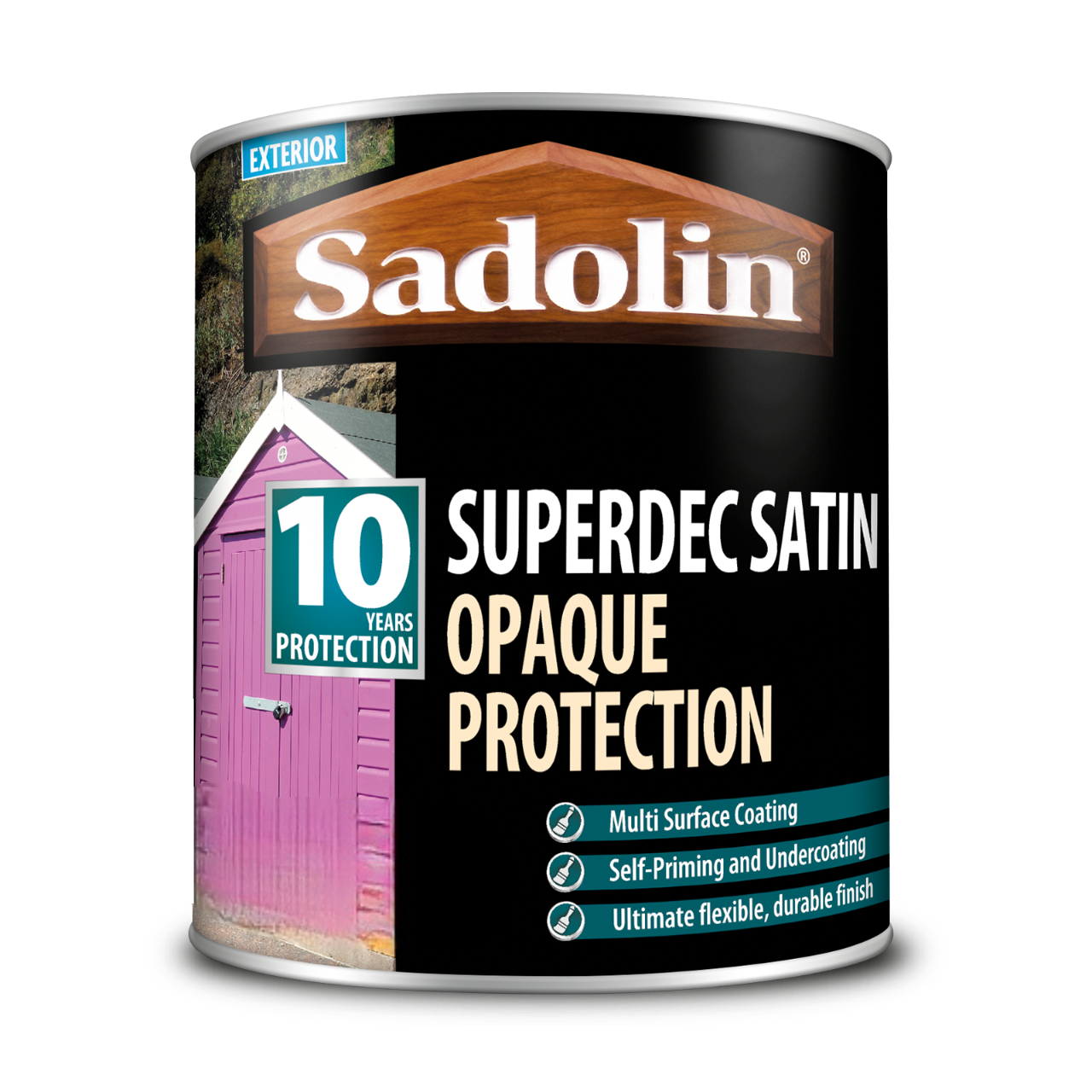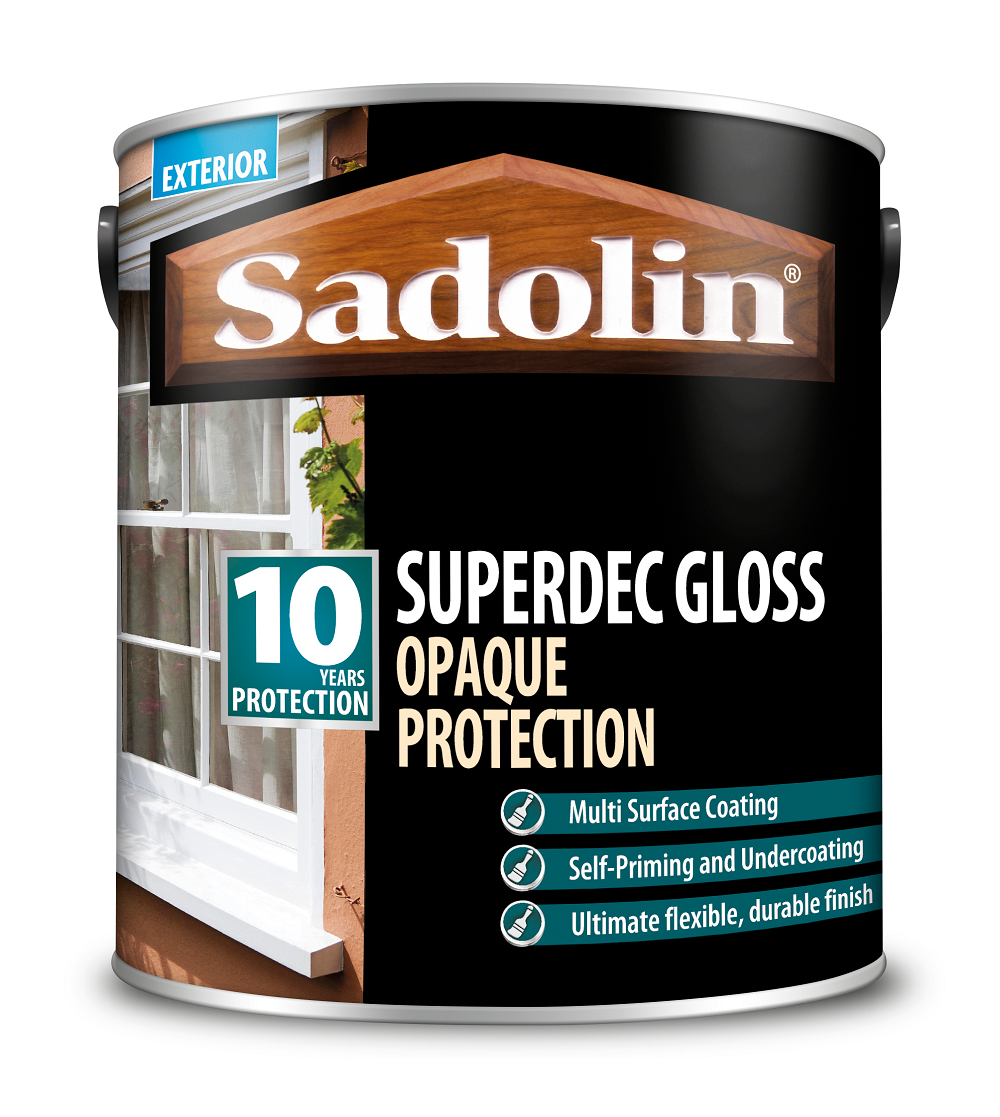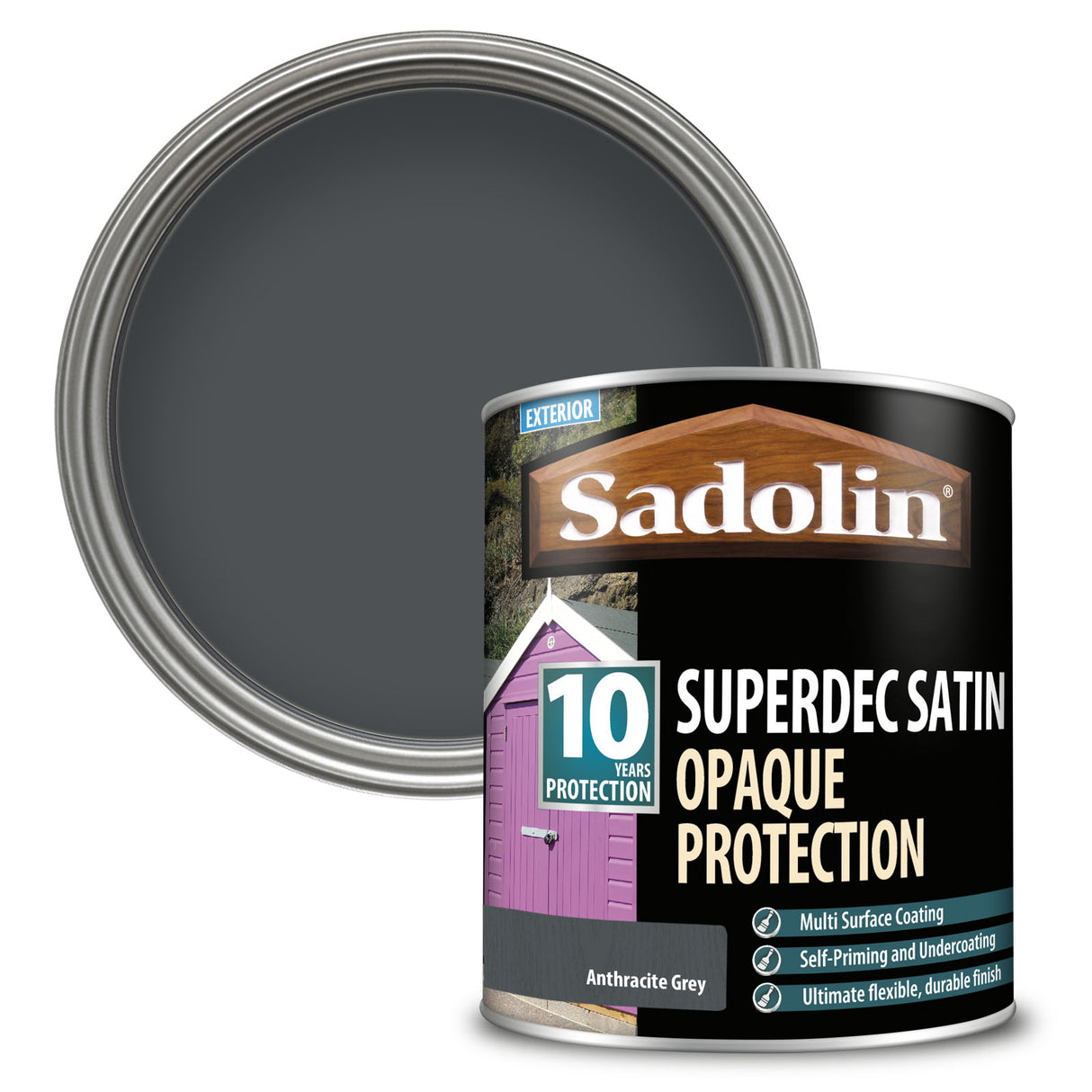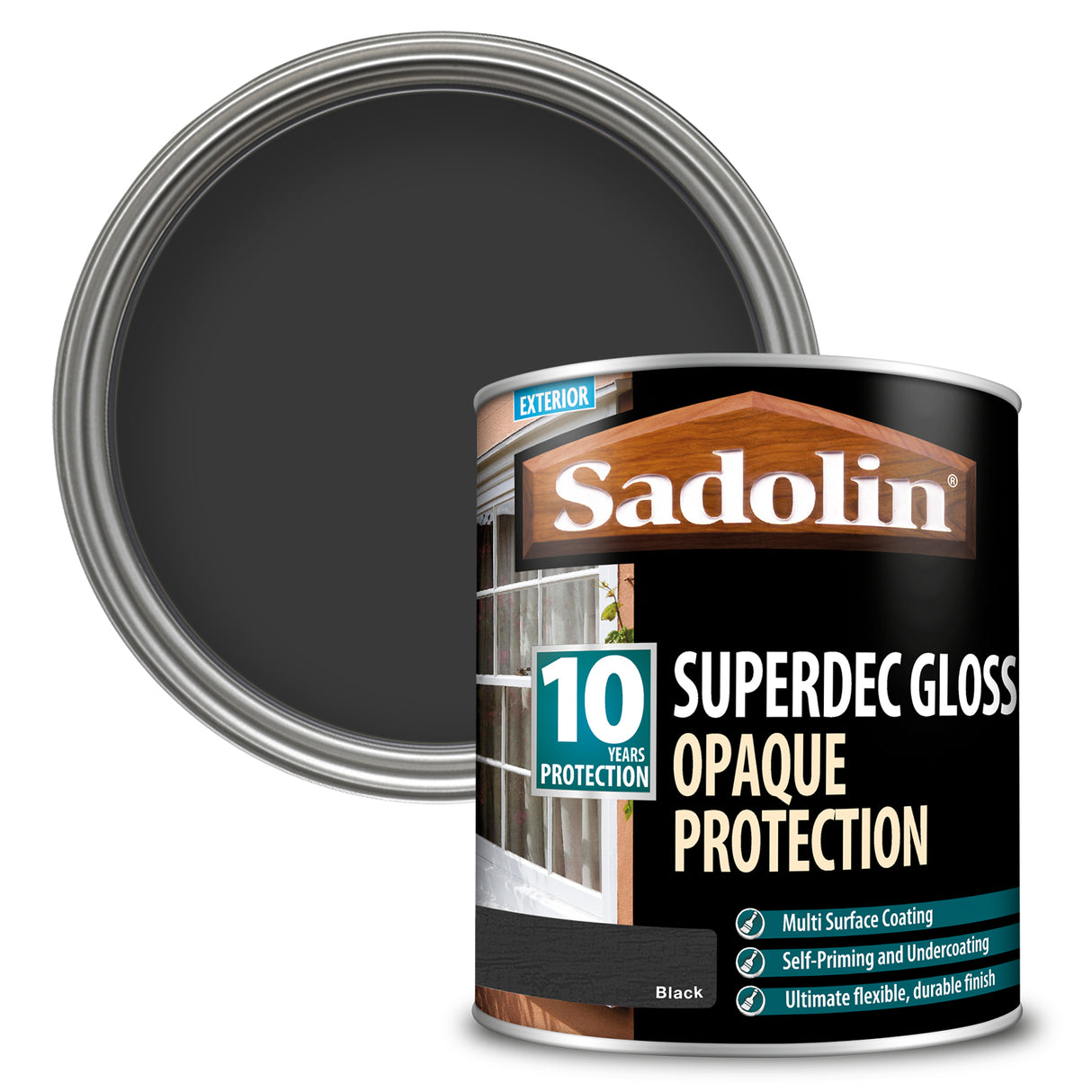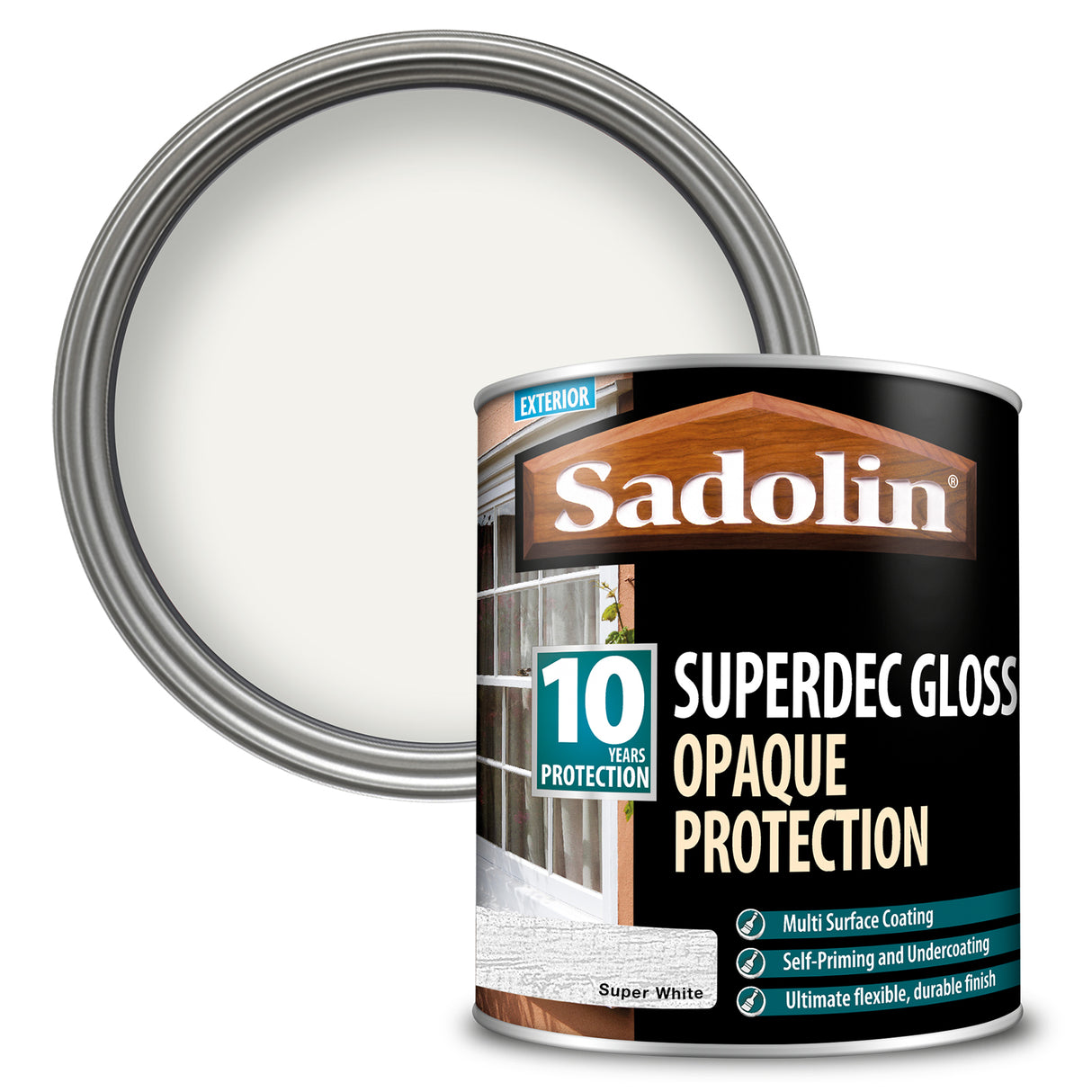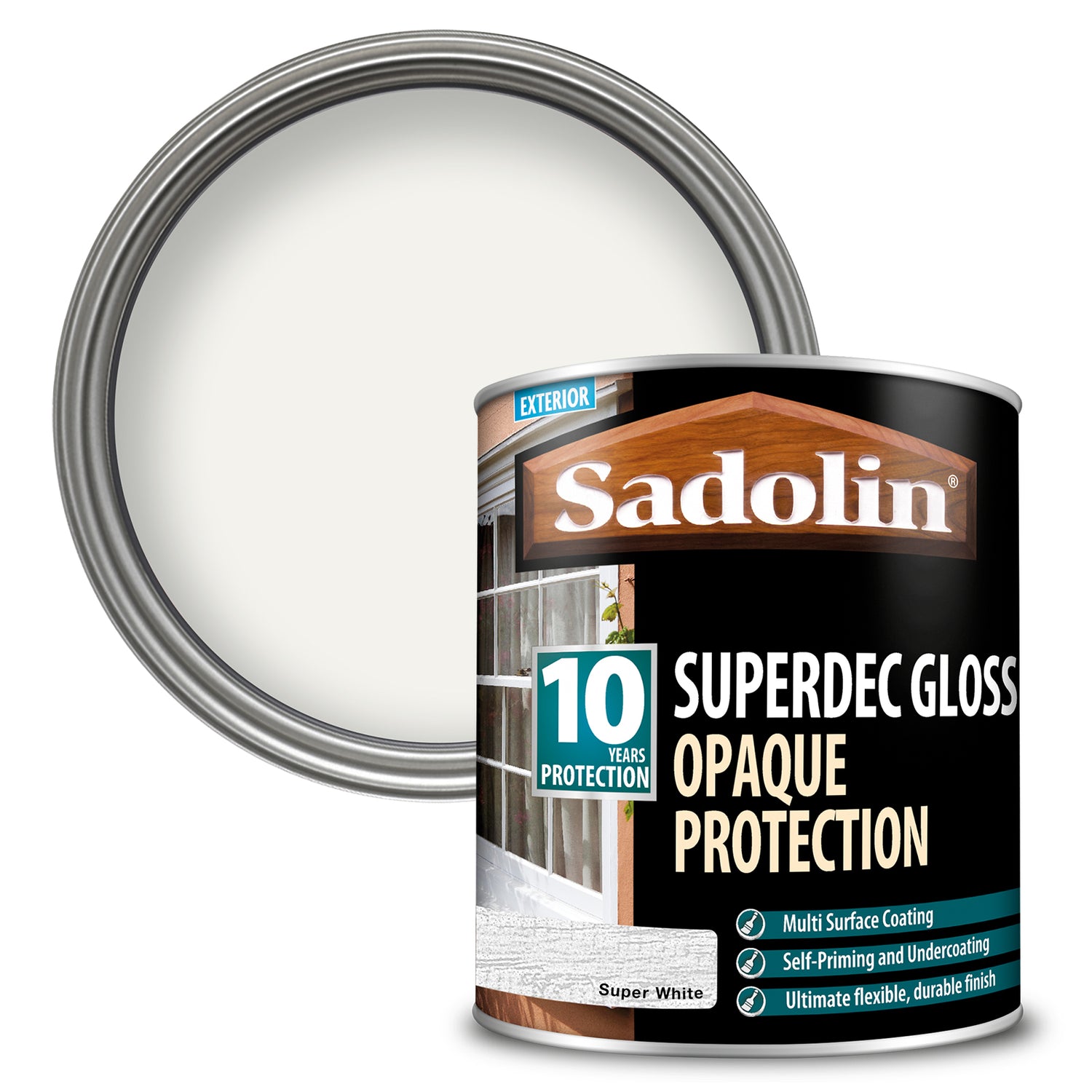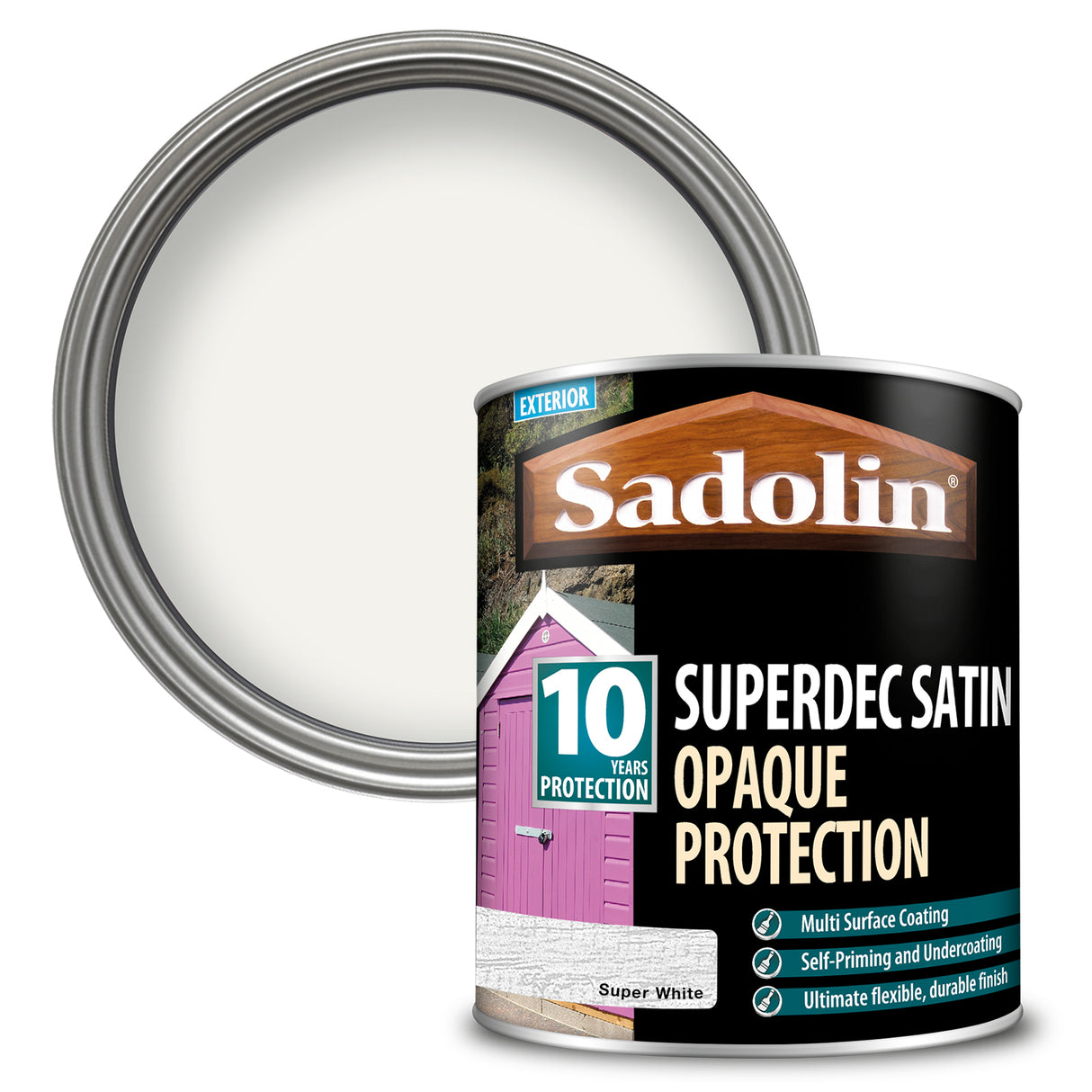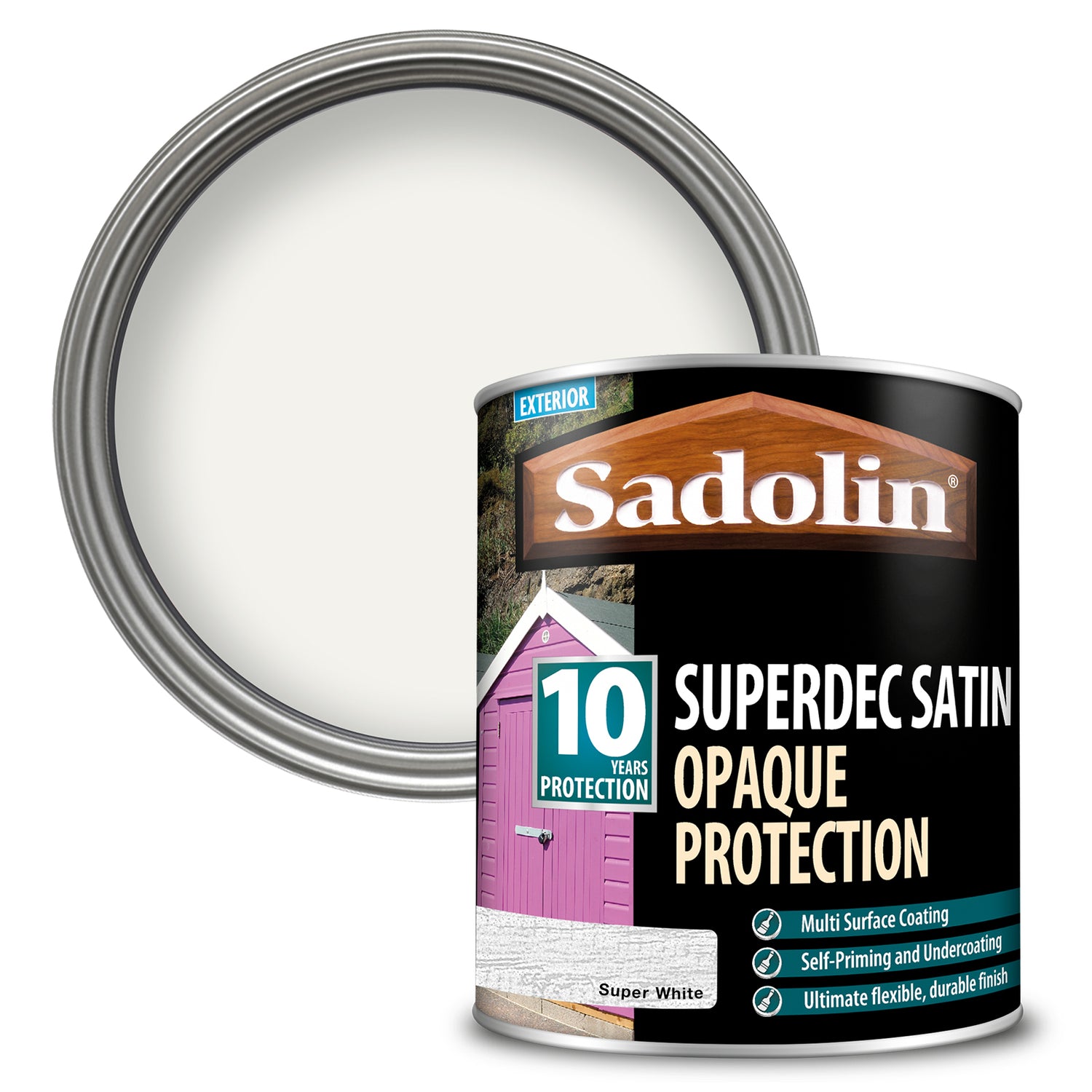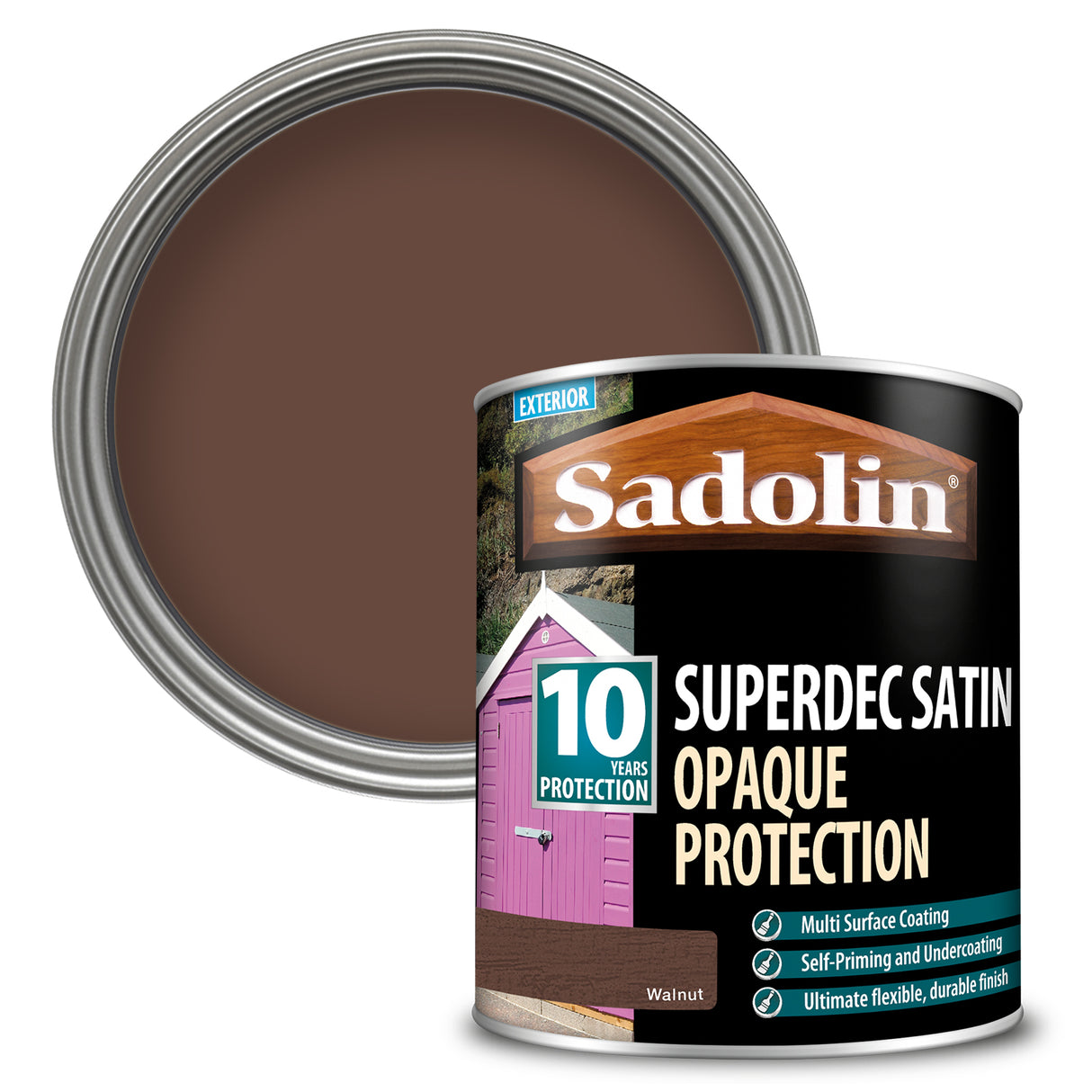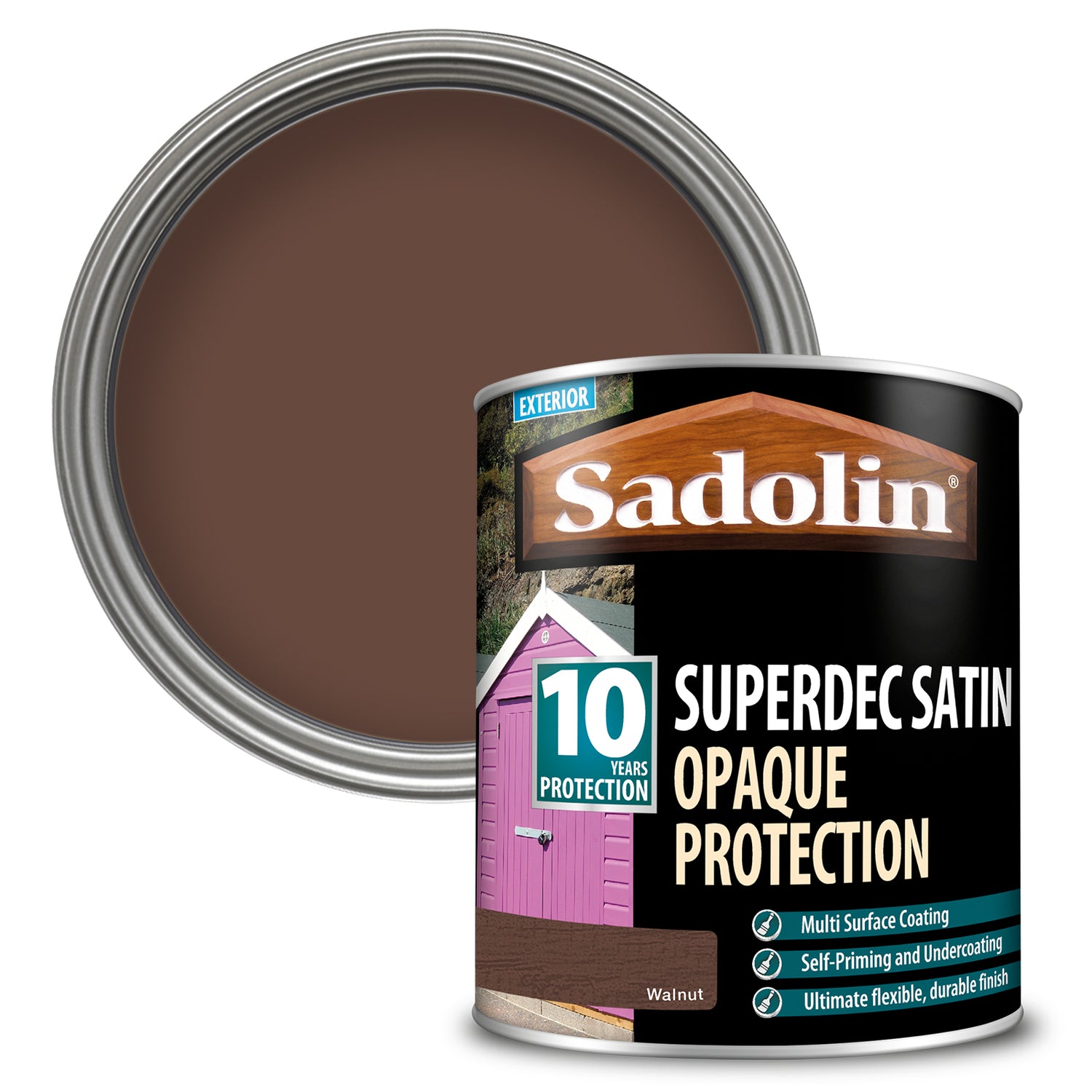Sadolin Superdec Opaque Wood Protection
Sadolin Superdec Opaque Wood Protection - 1L / Satin Anthracite Grey is backordered and will ship as soon as it is back in stock.
Couldn't load collection availability

Delivery charges will vary depending on your location.
To find out delivery cost to your postcode, add the products your require to your basket and then review your basket, entering the delivery postcode
We look to dispatch all products same-day where possible, we use a close network of couriers we have worked alongside for a number of years and will share any and all shipping updates with you directly.
Opaque wood protection solution suitable for various exterior joinery and timber applications.
Features
- Self-priming and water-based
- Ideal for exterior joinery such as windows, doors, and conservatories
- Can also be applied on weathered plastic, metal, cladding, concrete, and masonry surfaces
- Maintains flexibility and resists cracking, peeling, and flaking
- Dries to an opaque satin or gloss finish
- Provides up to 10 years of protection
- Low VOC levels
| Brand | Sadolin |
|---|---|
| No. of coats | 2 |
| Coverage | Up to 10m² per litre |
| Drying time | 4 hrs |
| Size | 1L, 2.5L, 5L (Depends on availability) |
Overview
Sadolin Superdec offers a versatile solution addressing common issues found with traditional paints. It's applicable on new, previously painted, or stained surfaces, making it ideal for situations requiring a complete colour change or for weathered surfaces with uneven appearances. Suitable for various surfaces, including:
- Exterior wood such as windows, doors, conservatories, fencing, and cladding
- Plastic, like PVCu
- Metal
- Concrete
- Brick
- Stone and Plastisol
Not recommended for use on wooden decking or floors, copper, polished concrete, or concrete floors. For decking, consider Sadolin Decking Oil, or explore our range of Decking Treatments.
Preparation
Before applying Sadolin Superdec, ensure that wooden surfaces are adequately prepared, clean, and dry, free from any surface dust or debris. The wood's moisture content should not exceed 18% prior to coating.
For new or untreated wood
- Remove any resinous deposits on bare timber, especially new wood, by wiping with a lint-free cloth dampened with methylated spirits.
- Avoid using knotting agents with Sadolin Opaque Wood Protection.
- Address minor surface defects, imperfections, or open joints using Sadolin Wood Filler or Sadolin Stainable Wood Filler.
- Exercise caution with general or 'All Purpose' fillers, as they may not be suitable.
- Utilise non-ferrous fixings, screws, and nails exclusively.
- Consider applying a suitable blocking primer to minimise extractive discoloration risks, especially with white or pale colours on resinous/knotty softwoods and coloured hardwoods.
- Wood exposed for over 4 weeks requires sanding back to a clean, sound surface if necessary.
- Pre-treat wood with Sadolin Quick Drying Wood Preserver before applying Sadolin Superdec if required.
- Lightly sand the surface in the direction of the grain to achieve a smooth surface, using a medium-grade abrasive paper.
- Avoid breaking through the existing surface coating.
- Thoroughly remove all wood dust.
- For localised damage or deterioration exceeding 3 months of exposure, sand affected areas back to a sound substrate before recoating.
For previously painted or varnished wood
- Lightly sand previously painted and varnished surfaces in good condition to aid adhesion.
- Wash down stained surfaces in good condition with warm water and detergent, allowing them to dry before application.
- For surfaces in poor condition, remove loose, flaking material with a scraper or abrasive paper, sanding in the direction of the grain.
- Remove any weathered timber, and sand the sound coating with abrasive paper to provide an adequate key.
- Strip any surfaces in poor condition bare and treat them as new wood.
- For localised damage or deterioration exceeding 3 months of exposure, sand affected areas back to a sound substrate before recoating.
For glazing
- Ensure the backs of new glazing beads, end grains, and rebates are finished with Superdec Opaque Wood Protection before fixing.
- Use a suitable sealant for glazing joinery to be coated with Sadolin Superdec.
- Avoid using linseed oil putty or modified, non-setting compounds in conjunction with our wood protection systems.
- Consult the manufacturer of the relevant glazing material to confirm compatibility.
- Apply silicone glazing materials only upon completion of the finishing coats.
Application
Before starting any project, it's essential to conduct a small test area to assess product suitability, adhesion, and finish. Always adhere to the manufacturer's instructions provided on the tin.
Avoid applying Sadolin Superdec Opaque Wood Protection if there's a risk of rain, or when air or substrate temperatures fall below 8°C or rise above 25°C. Additionally, refrain from application if the relative humidity exceeds 80% during application or drying periods. Protect the treated surface from frost and rain until fully dry to prevent adverse effects on drying, visual quality, and durability.
Thoroughly stir Sadolin Superdec Opaque Wood Protection before and during application to ensure consistent sheen and colour. This product is ready for use and should not be thinned.
Apply Sadolin Superdec in a full, flowing coat, ensuring complete coverage of all surfaces and end grains. For optimal results, utilise a high-quality synthetic fibre brush designed for waterborne products. Pay close attention to end grain, tops and bottoms of doors, and undersides of window sills during application.
Allow a minimum of 4 hours for drying before handling or recoating.
Aftercare
If you notice a lightening in colour, reduction in sheen, or loss of water repellency, it's time for maintenance. Lightly abrade the surface in the direction of the wood grain and clean using warm water and a mild detergent. Rinse thoroughly with clean water and allow the surface to dry completely. Once dry, apply a fresh coat of Sadolin Superdec Opaque Wood Protection.
For surfaces exhibiting severe flaking or peeling, where bare wood is exposed or greying has occurred, follow the full Preparation and Application instructions provided above.
Frequently asked questions
Do I need to seal knots in the wood before applying Superdec?
Generally, sealing knots is not necessary when using Sadolin Superdec, except when applying white or pale colours on resinous/knotty softwoods or coloured hardwoods. In such cases, it's advisable to use a suitable blocking primer initially to minimise the risk of discoloration from timber resins.
Will Superdec cover green residue?
Green residue, typically algae, should be removed with an algae remover like Ronseal Decking Cleaner and Reviver before applying paint. Failure to remove it may hinder paint adhesion.
What sheen level does Sadolin Superdec have? Is it glossy?
By default, Sadolin Superdec colours have a satin finish (mid sheen), unless specifically opting for the White/Black Gloss option.
Can I use Superdec on my wooden shed and fence panels?
Certainly, Superdec is suitable for various exterior projects, including wooden sheds and fence panels. It's recommended to lightly sand the surface with a medium-grade abrasive paper in the direction of the grain before application.
Datasheets
Sadolin Superdec Opaque Wood Protection - Safety Information
Sadolin Superdec Opaque Wood Protection - Technical Information

Description
Description
Opaque wood protection solution suitable for various exterior joinery and timber applications.
Features
- Self-priming and water-based
- Ideal for exterior joinery such as windows, doors, and conservatories
- Can also be applied on weathered plastic, metal, cladding, concrete, and masonry surfaces
- Maintains flexibility and resists cracking, peeling, and flaking
- Dries to an opaque satin or gloss finish
- Provides up to 10 years of protection
- Low VOC levels
| Brand | Sadolin |
|---|---|
| No. of coats | 2 |
| Coverage | Up to 10m² per litre |
| Drying time | 4 hrs |
| Size | 1L, 2.5L, 5L (Depends on availability) |
Overview
Sadolin Superdec offers a versatile solution addressing common issues found with traditional paints. It's applicable on new, previously painted, or stained surfaces, making it ideal for situations requiring a complete colour change or for weathered surfaces with uneven appearances. Suitable for various surfaces, including:
- Exterior wood such as windows, doors, conservatories, fencing, and cladding
- Plastic, like PVCu
- Metal
- Concrete
- Brick
- Stone and Plastisol
Not recommended for use on wooden decking or floors, copper, polished concrete, or concrete floors. For decking, consider Sadolin Decking Oil, or explore our range of Decking Treatments.
Preparation
Before applying Sadolin Superdec, ensure that wooden surfaces are adequately prepared, clean, and dry, free from any surface dust or debris. The wood's moisture content should not exceed 18% prior to coating.
For new or untreated wood
- Remove any resinous deposits on bare timber, especially new wood, by wiping with a lint-free cloth dampened with methylated spirits.
- Avoid using knotting agents with Sadolin Opaque Wood Protection.
- Address minor surface defects, imperfections, or open joints using Sadolin Wood Filler or Sadolin Stainable Wood Filler.
- Exercise caution with general or 'All Purpose' fillers, as they may not be suitable.
- Utilise non-ferrous fixings, screws, and nails exclusively.
- Consider applying a suitable blocking primer to minimise extractive discoloration risks, especially with white or pale colours on resinous/knotty softwoods and coloured hardwoods.
- Wood exposed for over 4 weeks requires sanding back to a clean, sound surface if necessary.
- Pre-treat wood with Sadolin Quick Drying Wood Preserver before applying Sadolin Superdec if required.
- Lightly sand the surface in the direction of the grain to achieve a smooth surface, using a medium-grade abrasive paper.
- Avoid breaking through the existing surface coating.
- Thoroughly remove all wood dust.
- For localised damage or deterioration exceeding 3 months of exposure, sand affected areas back to a sound substrate before recoating.
For previously painted or varnished wood
- Lightly sand previously painted and varnished surfaces in good condition to aid adhesion.
- Wash down stained surfaces in good condition with warm water and detergent, allowing them to dry before application.
- For surfaces in poor condition, remove loose, flaking material with a scraper or abrasive paper, sanding in the direction of the grain.
- Remove any weathered timber, and sand the sound coating with abrasive paper to provide an adequate key.
- Strip any surfaces in poor condition bare and treat them as new wood.
- For localised damage or deterioration exceeding 3 months of exposure, sand affected areas back to a sound substrate before recoating.
For glazing
- Ensure the backs of new glazing beads, end grains, and rebates are finished with Superdec Opaque Wood Protection before fixing.
- Use a suitable sealant for glazing joinery to be coated with Sadolin Superdec.
- Avoid using linseed oil putty or modified, non-setting compounds in conjunction with our wood protection systems.
- Consult the manufacturer of the relevant glazing material to confirm compatibility.
- Apply silicone glazing materials only upon completion of the finishing coats.
Application
Before starting any project, it's essential to conduct a small test area to assess product suitability, adhesion, and finish. Always adhere to the manufacturer's instructions provided on the tin.
Avoid applying Sadolin Superdec Opaque Wood Protection if there's a risk of rain, or when air or substrate temperatures fall below 8°C or rise above 25°C. Additionally, refrain from application if the relative humidity exceeds 80% during application or drying periods. Protect the treated surface from frost and rain until fully dry to prevent adverse effects on drying, visual quality, and durability.
Thoroughly stir Sadolin Superdec Opaque Wood Protection before and during application to ensure consistent sheen and colour. This product is ready for use and should not be thinned.
Apply Sadolin Superdec in a full, flowing coat, ensuring complete coverage of all surfaces and end grains. For optimal results, utilise a high-quality synthetic fibre brush designed for waterborne products. Pay close attention to end grain, tops and bottoms of doors, and undersides of window sills during application.
Allow a minimum of 4 hours for drying before handling or recoating.
Aftercare
If you notice a lightening in colour, reduction in sheen, or loss of water repellency, it's time for maintenance. Lightly abrade the surface in the direction of the wood grain and clean using warm water and a mild detergent. Rinse thoroughly with clean water and allow the surface to dry completely. Once dry, apply a fresh coat of Sadolin Superdec Opaque Wood Protection.
For surfaces exhibiting severe flaking or peeling, where bare wood is exposed or greying has occurred, follow the full Preparation and Application instructions provided above.
Frequently asked questions
Do I need to seal knots in the wood before applying Superdec?
Generally, sealing knots is not necessary when using Sadolin Superdec, except when applying white or pale colours on resinous/knotty softwoods or coloured hardwoods. In such cases, it's advisable to use a suitable blocking primer initially to minimise the risk of discoloration from timber resins.
Will Superdec cover green residue?
Green residue, typically algae, should be removed with an algae remover like Ronseal Decking Cleaner and Reviver before applying paint. Failure to remove it may hinder paint adhesion.
What sheen level does Sadolin Superdec have? Is it glossy?
By default, Sadolin Superdec colours have a satin finish (mid sheen), unless specifically opting for the White/Black Gloss option.
Can I use Superdec on my wooden shed and fence panels?
Certainly, Superdec is suitable for various exterior projects, including wooden sheds and fence panels. It's recommended to lightly sand the surface with a medium-grade abrasive paper in the direction of the grain before application.
Datasheets
Sadolin Superdec Opaque Wood Protection - Safety Information
Sadolin Superdec Opaque Wood Protection - Technical Information
Payment & Security
Payment methods
Your payment information is processed securely. We do not store credit card details nor have access to your credit card information.




